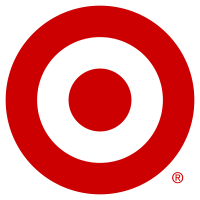
Cancel anytime
- Chart
- Upturn Summary
- Highlights
- Revenue
- Valuation
- Analyst Ratings
 Upturn AI SWOT
Upturn AI SWOT - About
Target Corporation (TGT)

- BUY Advisory
- SELL Advisory (Profit)
- SELL Advisory (Loss)
- Profit
- Loss
- Pass (Skip investing)

 Stock price based on last close
Stock price based on last close (see disclosures)
- ALL
- YEAR
- MONTH
- WEEK
Upturn Advisory Summary
04/01/2025: TGT (1-star) is currently NOT-A-BUY. Pass it for now.
Analysis of Past Performance
Type Stock | Historic Profit -2.6% | Avg. Invested days 44 | Today’s Advisory PASS |
Upturn Star Rating   | Upturn Advisory Performance | Stock Returns Performance |
Key Highlights
Company Size Large-Cap Stock | Market Capitalization 47.58B USD | Price to earnings Ratio 11.79 | 1Y Target Price 135.69 |
Price to earnings Ratio 11.79 | 1Y Target Price 135.69 | ||
Volume (30-day avg) 8494412 | Beta 1.18 | 52 Weeks Range 100.50 - 171.93 | Updated Date 04/1/2025 |
52 Weeks Range 100.50 - 171.93 | Updated Date 04/1/2025 | ||
Dividends yield (FY) 4.29% | Basic EPS (TTM) 8.86 |
Analyzing Revenue: Products, Geography and Growth
Revenue by Products
Product revenue - Year on Year
Revenue by Geography
Earnings Date
Report Date 2025-03-03 | When Before Market | Estimate 2.2508 | Actual 2.41 |
Profitability
Profit Margin 3.84% | Operating Margin (TTM) 4.94% |
Management Effectiveness
Return on Assets (TTM) 6.34% | Return on Equity (TTM) 29.12% |
Valuation
Trailing PE 11.79 | Forward PE 11.49 | Enterprise Value 62656959783 | Price to Sales(TTM) 0.45 |
Enterprise Value 62656959783 | Price to Sales(TTM) 0.45 | ||
Enterprise Value to Revenue 0.59 | Enterprise Value to EBITDA 7.24 | Shares Outstanding 455576000 | Shares Floating 454118619 |
Shares Outstanding 455576000 | Shares Floating 454118619 | ||
Percent Insiders 0.26 | Percent Institutions 83.76 |
Analyst Ratings
Rating 3.7 | Target Price 142.24 | Buy 3 | Strong Buy 12 |
Buy 3 | Strong Buy 12 | ||
Hold 21 | Sell 1 | Strong Sell - | |
Strong Sell - |
 Upturn AI SWOT
Upturn AI SWOT
Target Corporation

Company Overview
 History and Background
History and Background
Target Corporation was founded in 1902 as Goodfellow Dry Goods in Minneapolis, Minnesota. It was renamed Dayton's in 1911 and launched the first Target discount store in 1962. The company was renamed Target Corporation in 2000.
 Core Business Areas
Core Business Areas
- Retail: Operates general merchandise stores offering a wide variety of products including apparel, accessories, home decor, electronics, food, and hardlines.
 Leadership and Structure
Leadership and Structure
Brian Cornell serves as Chairman and CEO. The organizational structure is hierarchical with various executive vice presidents leading different functional areas.
Top Products and Market Share
 Key Offerings
Key Offerings
- Apparel and Accessories: Target offers a wide range of clothing and accessories for men, women, and children, including private label brands like Cat & Jack and Goodfellow & Co. Market share data varies by category, but Target competes with Walmart, Amazon, and specialty apparel retailers. Competitors include: Walmart (WMT), Amazon (AMZN), Old Navy (GPS), Gap (GPS).
- Food and Beverage: Target offers a variety of grocery items, including fresh produce, packaged foods, and beverages. Competitors include: Walmart (WMT), Kroger (KR), Costco (COST).
- Home Decor and Furnishings: Target's home decor and furnishing offerings include furniture, bedding, lighting, and decorative accessories. Competitors include: Walmart (WMT), Amazon (AMZN), Wayfair (WAY).
Market Dynamics
 Industry Overview
Industry Overview
The retail industry is highly competitive and dynamic, characterized by evolving consumer preferences, technological advancements, and increasing online competition.
Positioning
Target is positioned as a 'cheap chic' retailer, offering stylish and on-trend merchandise at affordable prices. Its competitive advantages include its strong brand reputation, differentiated product assortment, and omni-channel capabilities.
Total Addressable Market (TAM)
The total US retail market is estimated to be in the trillions of dollars. Target is well-positioned within this TAM due to its broad product offering and focus on value and style.
Upturn SWOT Analysis
Strengths
- Strong brand recognition
- Differentiated product assortment
- Omni-channel capabilities
- Loyalty program (Target Circle)
- Strategic store locations
Weaknesses
- Lower profit margins compared to some competitors
- Reliance on discretionary spending
- Inventory management challenges
- Vulnerable to data breaches
Opportunities
- Expansion of private label brands
- Growth in e-commerce sales
- Strategic partnerships
- Expansion into new markets
- Personalized customer experiences
Threats
- Intense competition from Walmart and Amazon
- Economic downturn impacting consumer spending
- Supply chain disruptions
- Changes in consumer preferences
- Increasing labor costs
Competitors and Market Share
 Key Competitors
Key Competitors
- Walmart (WMT)
- Amazon (AMZN)
- Costco (COST)
Competitive Landscape
Target differentiates itself through its 'cheap chic' positioning, offering stylish merchandise at affordable prices. Walmart focuses on everyday low prices, while Amazon emphasizes convenience and selection.
Major Acquisitions
Shipt
- Year: 2017
- Acquisition Price (USD millions): 550
- Strategic Rationale: Acquisition of Shipt enhances Target's same-day delivery capabilities.
Growth Trajectory and Initiatives
Historical Growth: Target has experienced consistent growth in revenue and earnings over the past decade, driven by its store expansion, e-commerce growth, and strategic initiatives.
Future Projections: Analysts project continued growth for Target, driven by its investments in omni-channel capabilities, private label brands, and strategic partnerships. Data to be added when available.
Recent Initiatives: Recent strategic initiatives include the expansion of its fulfillment network, the launch of new private label brands, and the implementation of personalized customer experiences.
Summary
Target is a strong retail company with a well-defined brand and a loyal customer base. Its omnichannel capabilities and strategic initiatives are driving growth. However, it faces intense competition and must effectively manage its supply chain and inventory to maintain its competitive edge. Data breaches remain a significant concern.
Similar Companies
AMZN

Amazon.com Inc
AMZN

Amazon.com Inc
COST

Costco Wholesale Corp
COST

Costco Wholesale Corp
ROST

Ross Stores Inc
ROST

Ross Stores Inc
TJX

The TJX Companies Inc
TJX

The TJX Companies Inc
WMT

Walmart Inc
WMT

Walmart Inc
Sources and Disclaimers
Data Sources:
- SEC Filings
- Company Reports
- Market Research Reports
- Analyst Estimates
Disclaimers:
The information provided is for informational purposes only and should not be considered financial advice. Market conditions and company performance are subject to change.

![]() AI Summarization is directionally correct and might not be accurate.
AI Summarization is directionally correct and might not be accurate.

![]() Summarized information shown could be a few years old and not current.
Summarized information shown could be a few years old and not current.

![]() Fundamental Rating based on AI could be based on old data.
Fundamental Rating based on AI could be based on old data.

![]() AI-generated summaries may have inaccuracies (hallucinations). Please verify the information before taking action.
AI-generated summaries may have inaccuracies (hallucinations). Please verify the information before taking action.
About Target Corporation
Exchange NYSE | Headquaters Minneapolis, MN, United States | ||
IPO Launch date 1983-04-06 | Chairman of the Board & CEO Mr. Brian C. Cornell | ||
Sector Consumer Defensive | Industry Discount Stores | Full time employees 440000 | Website https://target.com |
Full time employees 440000 | Website https://target.com | ||
Target Corporation operates as a general merchandise retailer in the United States. The company offers apparel for women, men, young adults, kids, toddlers, and babies, as well as jewelry, accessories, and shoes; and beauty products, such as skin and bath care, cosmetics, hair care, oral care, deodorant, and shaving products. It also provides food and beverage products comprising dry and perishable grocery, including snacks, candy, beverages, deli, bakery, meat, produce, and food service; electronics which includes video games and consoles, toys, sporting goods, entertainment, and luggage; bed and bath, home décor, school/office supplies, storage, small appliances, kitchenware, greeting cards, party supplies, furniture, lighting, home improvement, and seasonal merchandise; and household essentials, such as household cleaning, paper products, over-the-counter healthcare, vitamins and supplements, baby gear, and pet supplies. In addition, the company sells merchandise through periodic design and creative partnerships, and shop-in-shop experience; and in-store amenities. It sells its products through its stores; and digital channels, including Target.com. Target Corporation was incorporated in 1902 and is headquartered in Minneapolis, Minnesota.
Note: This website is maintained by Upturn Corporation, which is an investment adviser registered with the U.S. Securities and Exchange Commission. Such registration does not imply a certain level of skill or training. Investing in securities has risks. Past performance is no guarantee of future returns. No assurance is provided as to any particular investment return, and you may lose money using our services. You are strongly advised to consult appropriate counsel before making any investments in companies you learn about through our services. You should obtain appropriate legal, tax, investment, accounting, and other advice that takes into account your investment portfolio and overall financial situation. You are solely responsible for conducting due diligence on a potential investment. We do not affect trades for you. You will select your own broker through which to transact. Investments are not FDIC insured, they are not guaranteed, and they may lose value. Please see the Privacy Policy, Terms of Use, and Disclosure for more information.


 Home
Home 

